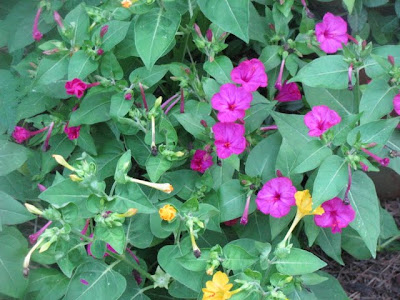Posted by: Dawn
I'm glad Tina has posted many of her wildflowers for Wildflower Wednesday, wildflowers are among my favorite spontaneous surprises in the world.
The three photos are of wood lilies that have decided to take up residence in my yard.
The wood lily (Lillium philadelphicum) is also known as; Philadelphia lily, prairie lily and western red lily, they are native to North America. This flower is recognized by it's unique open petals and the ability for the gardener to see through it by the spaces at the bottom of each petals. The wood lily can be between 1 ft and 3 feet tall, it has whorled leaves and will grow in most all conditions (shady, part shade and full sun). It prefers well rotted soil that is dry. They seem to have popped up wherever they want to, germinating by airborne seeds although it has a rough pineapple looking bulb.
This flower is recognized by it's unique open petals and the ability for the gardener to see through it by the spaces at the bottom of each petals. The wood lily can be between 1 ft and 3 feet tall, it has whorled leaves and will grow in most all conditions (shady, part shade and full sun). It prefers well rotted soil that is dry. They seem to have popped up wherever they want to, germinating by airborne seeds although it has a rough pineapple looking bulb. The wood lily is endangered in Maryland, New Mexico, Tennessee, and North Carolina. They are threatened in Kentucky and Ohio. It is featured on the Saskatchewan flag and is protected against uprooting, picked or destroyed. It grows along edges of woodland forests but this one likes my group of phlox.
The wood lily is endangered in Maryland, New Mexico, Tennessee, and North Carolina. They are threatened in Kentucky and Ohio. It is featured on the Saskatchewan flag and is protected against uprooting, picked or destroyed. It grows along edges of woodland forests but this one likes my group of phlox.
 The Indians used this lily as a boiled paste, for application on sores, bruises and swelling wounds. They used it as a tea for stomach problems.
The Indians used this lily as a boiled paste, for application on sores, bruises and swelling wounds. They used it as a tea for stomach problems.
 This flower is recognized by it's unique open petals and the ability for the gardener to see through it by the spaces at the bottom of each petals. The wood lily can be between 1 ft and 3 feet tall, it has whorled leaves and will grow in most all conditions (shady, part shade and full sun). It prefers well rotted soil that is dry. They seem to have popped up wherever they want to, germinating by airborne seeds although it has a rough pineapple looking bulb.
This flower is recognized by it's unique open petals and the ability for the gardener to see through it by the spaces at the bottom of each petals. The wood lily can be between 1 ft and 3 feet tall, it has whorled leaves and will grow in most all conditions (shady, part shade and full sun). It prefers well rotted soil that is dry. They seem to have popped up wherever they want to, germinating by airborne seeds although it has a rough pineapple looking bulb. The wood lily is endangered in Maryland, New Mexico, Tennessee, and North Carolina. They are threatened in Kentucky and Ohio. It is featured on the Saskatchewan flag and is protected against uprooting, picked or destroyed. It grows along edges of woodland forests but this one likes my group of phlox.
The wood lily is endangered in Maryland, New Mexico, Tennessee, and North Carolina. They are threatened in Kentucky and Ohio. It is featured on the Saskatchewan flag and is protected against uprooting, picked or destroyed. It grows along edges of woodland forests but this one likes my group of phlox. The Indians used this lily as a boiled paste, for application on sores, bruises and swelling wounds. They used it as a tea for stomach problems.
The Indians used this lily as a boiled paste, for application on sores, bruises and swelling wounds. They used it as a tea for stomach problems.This wildflower blooms from July (about the 4th) to August. It almost seems to me that the blooms last for about 2 weeks.
Pretty flower, In the Garden
Words and Photos Property of In the Garden Blog Team
Words and Photos Property of In the Garden Blog Team






































 Here you see Cypress Vine from seeds passed along from Nina's garden. You may recall Nina as one of the original 7 commenter's in the beginning of "In the Garden" Blog.
Here you see Cypress Vine from seeds passed along from Nina's garden. You may recall Nina as one of the original 7 commenter's in the beginning of "In the Garden" Blog. 







